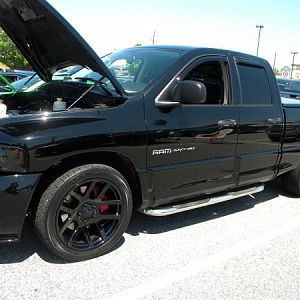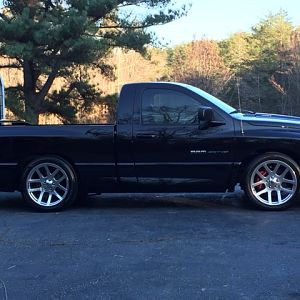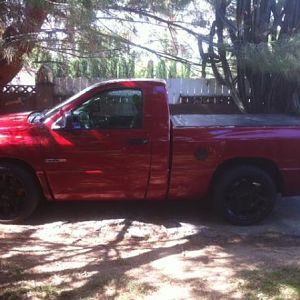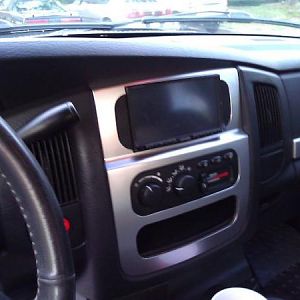No idea .. it’s the season to be jolly though and maybe he’s playing SantaI guess Ronnie quit???
a moderator could prune this thread and rid it of the off topic trash and maybe Ronnie will return??
You are using an out of date browser. It may not display this or other websites correctly.
You should upgrade or use an alternative browser.
You should upgrade or use an alternative browser.
Any Questions?
- Thread starter rottenronnie
- Start date
Probably a good Idea !I guess Ronnie quit???
a moderator could prune this thread and rid it of the off topic trash and maybe Ronnie will return??
- Joined
- May 18, 2006
- Messages
- 27,109
- Reaction score
- 4,496
HemiLonestar / can you prune the weeds from this thread?? We shouldn't have trashed Ronnie's thread
thank you!
thank you!
HemiLonestar / can you prune the weeds from this thread?? We shouldn't have trashed Ronnie's thread
thank you!
No worries.
- Joined
- May 18, 2006
- Messages
- 27,109
- Reaction score
- 4,496
Oh there you are! Glad to see you RonnieNo worries.
Hey Ronnie ,
Are the gen 4 heads manifold and valve covers a direct bolt on replacement on the Trucks , gen 3 engines ? Is there a performance gains also and compared to the Striker heads ?
PS: does the intake manifold have easier access to the bolts for removal ? Can the gen 4 be used with the factory gen 3 head as a simple bolt on ?
gen4
Gen IV heads are not a direct bolt-on replacement for Gen IIIs and also require a different intake and exhaust manifold or headers.
Strikers are a direct bolt-on and can use the Gen III Intake and Exhaust manifolds.
Gen IVs have a bit better mid-lift performance than Strikers out of the box.
I'd still choose Strikers given the choice AND they are meatier to support further porting whereas the Gen IVs aren't.
As the Gen III Vipers using Strikers created major confusion in Europe when racing the new GEN IV Vipers, Mr. Morys (Father Striker) was forced to make a decision: Quit making and selling Strikers or quit working at Chrysler.
Last edited:
So more trouble that it’s worth ..Gen IV heads are not a direct bolt-on replacement for Gen IIIs and also require a different intake and exhaust manifold or headers.
Strikers are a direct bolt-on and can use the Gen III Intake and Exhaust manifolds.
Gen IVs have a bit better mid-lift performance than Strikers out of the box.
I'd still choose Strikers given the choice AND they are meatier to support further porting whereas the Gen IVs aren't.
As the Gen III Vipers using Strikers created major confusion in Europe when racing the new GEN IV Vipers, Mr. Morys (Father Striker) was forced to make a decision: Quit making and selling Strikers or quit working at Chrysler.
Years ago you could tune an engine for best efficiency and power by optimizing using a vacuum gauge . Adjusting vacuum advance , carburetor adjustments , advancing the cams with offset keys and such .
My guess is that with all these electronic and computers there is nothing you can do to improve on todays engines except major expensive adjustments , modifications and tools .. any input ?
What is the stock engine vacuum and any simple ways of adjusting for efficiency, and power ?
My guess is that with all these electronic and computers there is nothing you can do to improve on todays engines except major expensive adjustments , modifications and tools .. any input ?
What is the stock engine vacuum and any simple ways of adjusting for efficiency, and power ?
- Joined
- May 18, 2006
- Messages
- 27,109
- Reaction score
- 4,496
Sure wish someone would ask an important question!! Ronnie has so much info that I enjoy reading and learning from. I've read this thread and it's full of knowledge - until it degraded that is
Years ago you could tune an engine for best efficiency and power by optimizing using a vacuum gauge . Adjusting vacuum advance , carburetor adjustments , advancing the cams with offset keys and such .
My guess is that with all these electronic and computers there is nothing you can do to improve on todays engines except major expensive adjustments , modifications and tools .. any input ?
What is the stock engine vacuum and any simple ways of adjusting for efficiency, and power ?
A stock Gen III at sea-level idles at 12" of Vacuum at operating temperature with 0-40 oil.
My own egine idles at 10" with an 11:1 compression ratio, a bit of a cam, a 3700-foot elevation, and 0-30 oil.
There aren't any magic tunes that will provide better economy.
It is frustrating not to be able to adjust the basics without diving into the E.C.U.
Thanks for the compliment(s) Wifey! Glad you are getting some useful tidbits out of the info exchanges!
Last edited:
beastmode1
Full Access Member
Ronnie happy new year I got a question for you. My 10 has still the original Champion spark plugs and I am fixing to change them out, Truck has just turned 70k what would you recommend manual shows Champions, which I have 10 RC 12ECC. Also how do you get to the ones in the far back? what gapping would you recommend? Thank you for your help.See above.
beastmode1
Full Access Member
My mom always says a dumb question is the one that goes un answered but I agree with you Ronnie it takes aSome guys just lurk and are timid to ask any questions. I remember a guy showing me a spark plug years ago and thought it was the threaded screw on top that provided "the gap". A valid observation as what other part would seem to be "adjustable"??
I guess I could have rolled on the floor laughing but I've never been "that guy".
Maybe 55 years of being in this hobby has taught me patience.
lot of patience.
Ronnie happy new year I got a question for you. My 10 has still the original Champion spark plugs and I am fixing to change them out, Truck has just turned 70k what would you recommend manual shows Champions, which I have 10 RC 12ECC. Also how do you get to the ones in the far back? what gapping would you recommend? Thank you for your help.
The stock Champions work just fine, although I've always preferred NGK.
The ones in the rear can be accessed with a shorter extension and swivel joint.
A gap of .038 to .040 works well.
Also, I wouldn't recommend any anti-sieze lube for installing new plugs as it tends to interfere with heat transfer.
Plugs do wear out slowly. Because the ignition systems are WAY more powerful than they used to be, the engines can still run "fine", BUT fuel-economy suffers because the spark can be weak and (ignition-timing wise)- late; as in not the optimum time to start the mix burning.
You might consider replacing your plug wires too, if you haven't done so.
Best of luck for the remainder of 2024 !!
Last edited:
- Joined
- May 18, 2006
- Messages
- 27,109
- Reaction score
- 4,496
This here is what I'm talking about! Great questions with great answers! Thank you!!
- Joined
- May 18, 2006
- Messages
- 27,109
- Reaction score
- 4,496
@rottenronnie or whoever took time to read this
Question .....
I'm going to be getting the old girl off her Throne this spring and outfit her with some new slippers and she needs belts and hoses and the usual oil change, etc
There isn't many choices for repair shops in the area and it's too far to take her out of state to my nephew for the work. The lical stealership SUX so that's not an option either
no one has ever touched her in this fashion, are belts and hoses fairly simple or do I need to get her to a specialist?
I'm the nervous mom type and don't even trust the dealership with my Tucson without me watching everything lol
How long would this kind of service take? One day?
What else is important to take care of?
Question .....
I'm going to be getting the old girl off her Throne this spring and outfit her with some new slippers and she needs belts and hoses and the usual oil change, etc
There isn't many choices for repair shops in the area and it's too far to take her out of state to my nephew for the work. The lical stealership SUX so that's not an option either
no one has ever touched her in this fashion, are belts and hoses fairly simple or do I need to get her to a specialist?
I'm the nervous mom type and don't even trust the dealership with my Tucson without me watching everything lol
How long would this kind of service take? One day?
What else is important to take care of?
Belts and hoses are straightforward stuff....finding some those replacements may be a problem you run into. I seem to recall one of the rad hoses being completely unobtainable nowadays.
How long has it been sitting?
How long has it been sitting?
- Joined
- May 18, 2006
- Messages
- 27,109
- Reaction score
- 4,496
Last driven 2018. It's been started several times and on a battery tender all the time.Belts and hoses are straightforward stuff....finding some those replacements may be a problem you run into. I seem to recall one of the rad hoses being completely unobtainable nowadays.
How long has it been sitting?
I'll start looking for the hoses!
You will need to rent or buy the long tool for releasing the tension on the serpentine belt. Find the oem belt sticker or take some pictures before removing it.
There is ONE belt to buy.
Some hoses like to stick in place but a good twist or two will break them free for replacement.
Before you remove the hoses, drain the coolant from the rad (take the rad cap off first). There is a black plastic twist tap down low, towards the Driver's side. If you are working on Kiwi's truck, he may tell you something different. This "twist tap" also has a spout. Find the right size hose to slip over the spout before opening so you can direct the Coolant into a catch basin. Close the tap.
The tension-clamps on the hoses can be a little challenging to release (one at each end of each hose), but not too bad with the right sized pliers, or you can buy the proper tool for that too.
Buy new Coolant. Make sure it is the right kind. I like the Mopar stuff.
Once your new hoses are installed and clamped, and your new belt is on, open the small bleeder on top of the thermostat housing. This will let air out while you are filling the rad with new Coolant.
Start it up and if your bleeder is doing a geyser impression, close it a bit but still leave it open. Add fluid until your rad is full then once it warms up and the thermostat opens, you may need to add a bit more.
When pure fluid starts coming out of the bleeder, you can close it.
Add Coolant to your Overflow bucket, if needed.
Check for leaks, put your rad cap on and wait until the engine is up to temp then check for leaks again.
Go for a drive and enjoy the day.
After the engine has cooled down, remove the Rad Cap one more time and make sure the rad is full.
P.S.The old Coolant may look fine but corrosion inhibitors get depleted. Dissimilar metals in close proximity, are particularly hard on corrosion inhibitors and is the reason for some engines having head gasket issues over time, IF the Coolant wasnt regularly changed.
P.S.S.
Don't leave the old Coolant in open containers. Cats seem to like it and you may find them later "sleeping" on their backs with their legs straight up. (It's quite toxic.)
There is ONE belt to buy.
Some hoses like to stick in place but a good twist or two will break them free for replacement.
Before you remove the hoses, drain the coolant from the rad (take the rad cap off first). There is a black plastic twist tap down low, towards the Driver's side. If you are working on Kiwi's truck, he may tell you something different. This "twist tap" also has a spout. Find the right size hose to slip over the spout before opening so you can direct the Coolant into a catch basin. Close the tap.
The tension-clamps on the hoses can be a little challenging to release (one at each end of each hose), but not too bad with the right sized pliers, or you can buy the proper tool for that too.
Buy new Coolant. Make sure it is the right kind. I like the Mopar stuff.
Once your new hoses are installed and clamped, and your new belt is on, open the small bleeder on top of the thermostat housing. This will let air out while you are filling the rad with new Coolant.
Start it up and if your bleeder is doing a geyser impression, close it a bit but still leave it open. Add fluid until your rad is full then once it warms up and the thermostat opens, you may need to add a bit more.
When pure fluid starts coming out of the bleeder, you can close it.
Add Coolant to your Overflow bucket, if needed.
Check for leaks, put your rad cap on and wait until the engine is up to temp then check for leaks again.
Go for a drive and enjoy the day.
After the engine has cooled down, remove the Rad Cap one more time and make sure the rad is full.
P.S.The old Coolant may look fine but corrosion inhibitors get depleted. Dissimilar metals in close proximity, are particularly hard on corrosion inhibitors and is the reason for some engines having head gasket issues over time, IF the Coolant wasnt regularly changed.
P.S.S.
Don't leave the old Coolant in open containers. Cats seem to like it and you may find them later "sleeping" on their backs with their legs straight up. (It's quite toxic.)
Last edited:
Call stinker
Is he still in business??
Support Us
Become A Supporting Member Today!





